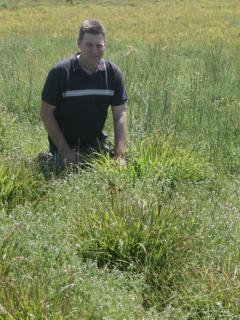Subterranean clover
Subterranean clover is a grazing tolerant annual pasture legume which is a proven companion for kikuyu on the SC, except on deep sands. In general where subterranean clover can be grown then it will be more persistent and produce more biomass under regular grazing than the alternative annual legumes. Many kikuyu stands on the SC have a high clover density and are more productive than annual pastures. In the NAR subterranean clover is poorly adapted to most of the soils used for growing sub-tropical grasses.
A range of cultivars are available for areas ranging from 275 to 1200mm average annual rainfall. Subterranean clover has three subspecies (ssp): – ssp. subterraneum is adapted to well-drained, moderately acidic soils; ssp. yanninicum to moderately acidic soils with poor drainage; while ssp. brachycalycinum is best suited to neutral-alkaline, cracking clay or stony soils and generally fails to persist on Western Australian (WA) soils.
Subterranean clover has several features that make it well adapted as a companion legume: it tolerates regular, close grazing (particularly set-stocking by sheep) due to its prostrate growth habit, buries its burrs to protect seeds from being eaten by stock and maintains a seed bank of ‘hard’ seeds, enabling regeneration after pasture cropping or a year with little or no seed-set.
Weaknesses include a shallow root system, susceptibility to redlegged earth mites (RLEM), particularly at the seedling stage and in dry years on the SC kikuyu competes strongly for soil moisture and can exacerbate the effect of a false break leading to failed or poor establishment of subterranean clover.
Managing subterranean clover in kikuyu pastures
The key to managing subterranean clover in kikuyu stands is to maintain a good clover density and soil seed bank. This requires that grazing pressure is applied to kikuyu before the break of the season to keep the sward open, adequate soil fertility for the clover and RLEM control as required. If these tactics prove insufficient then suppression of kikuyu with a grass selective herbicide such as clethodim following the break of season can substantially lift legume content by reducing kikuyu competition.
If stands have an inadequate clover seed bank a combination of grass suppression and re-seeding will successfully re-establish subterranean clover.
Cultivar characteristics
A range of cultivars are available for areas ranging from 275 to 1200mm average annual rainfall. Flowering time is the most important character that determines cultivar persistence in an environment, as it determines the amount of seed that can be set. Other features to consider when selecting a variety include oestrogen levels, hardseededness, disease resistance and redlegged eath mite resistance.
As a companion legume mixing two or more cultivars with up to two to three weeks difference in flowering time is one way to account for seasonal differences and the competition from kikuyu in spring.

